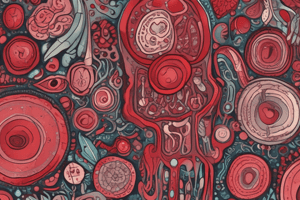Podcast
Questions and Answers
What is anemia characterized by?
What is anemia characterized by?
- A normal level of red blood cells
- An increase in red blood cells
- A decrease in red blood cells or the amount of hemoglobin in the blood (correct)
- An overproduction of red blood cells
What is a common symptom of anemia?
What is a common symptom of anemia?
- Fatigue (correct)
- Headaches and diarrhea
- High blood pressure
- Weight loss
What type of anemia is caused by a vitamin deficiency?
What type of anemia is caused by a vitamin deficiency?
- Hemolytic anemia
- Iron deficiency anemia
- Vitamin deficiency anemia (correct)
- Chronic disease anemia
What is polycythemia characterized by?
What is polycythemia characterized by?
What is a common cause of secondary polycythemia?
What is a common cause of secondary polycythemia?
What is a treatment option for polycythemia?
What is a treatment option for polycythemia?
What is used to evaluate red blood cell production in anemia?
What is used to evaluate red blood cell production in anemia?
What is a complication of polycythemia?
What is a complication of polycythemia?
Flashcards are hidden until you start studying
Study Notes
Anemia
Definition
- A condition characterized by a decrease in red blood cells (RBCs) or the amount of hemoglobin in the blood
- Impairs the body's ability to transport oxygen to tissues and organs
Causes
- Blood loss (e.g., hemorrhage)
- Decreased RBC production (e.g., iron deficiency, vitamin deficiency, chronic diseases)
- Increased RBC destruction (e.g., hemolytic anemia)
Symptoms
- Fatigue
- Weakness
- Shortness of breath
- Dizziness
- Pale skin
- Headaches
Types
- Iron deficiency anemia
- Vitamin deficiency anemia (e.g., B12, folate)
- Chronic disease anemia (e.g., kidney disease, rheumatoid arthritis)
- Hemolytic anemia (e.g., sickle cell disease, thalassemia)
Diagnosis
- Complete Blood Count (CBC) to measure RBC count, hemoglobin, and hematocrit
- Peripheral blood smear to examine RBC morphology
- Bone marrow biopsy to evaluate RBC production
Polycythemia
Definition
- A condition characterized by an overproduction of RBCs
- Increases blood viscosity and risk of blood clots
Causes
- Primary polycythemia (e.g., polycythemia vera, a genetic disorder)
- Secondary polycythemia (e.g., high altitude, chronic lung disease, tumors)
Symptoms
- Headaches
- Dizziness
- Fatigue
- Shortness of breath
- Increased blood pressure
- Increased risk of blood clots and stroke
Diagnosis
- CBC to measure RBC count, hemoglobin, and hematocrit
- Blood tests to evaluate erythropoietin levels
- Bone marrow biopsy to evaluate RBC production
Treatment
- Phlebotomy to reduce RBC count
- Medications to reduce blood production (e.g., hydroxyurea)
- Low-dose aspirin to reduce blood clotting risk
Anemia
Definition and Effects
- A condition characterized by decreased red blood cells (RBCs) or hemoglobin, impairing oxygen transport to tissues and organs
- Results in reduced oxygen delivery to tissues and organs
Causes
- Blood loss (e.g., hemorrhage)
- Decreased RBC production (e.g., iron deficiency, vitamin deficiency, chronic diseases)
- Increased RBC destruction (e.g., hemolytic anemia)
Symptoms
- Fatigue and weakness due to inadequate oxygen delivery
- Shortness of breath and dizziness from reduced oxygen levels
- Pale skin due to decreased RBCs and hemoglobin
- Headaches from inadequate oxygen supply
Types
- Iron deficiency anemia: inadequate iron for hemoglobin production
- Vitamin deficiency anemia: inadequate vitamins (e.g., B12, folate) for RBC production
- Chronic disease anemia: underlying diseases (e.g., kidney disease, rheumatoid arthritis) affecting RBC production
- Hemolytic anemia: RBC destruction due to genetic disorders (e.g., sickle cell disease, thalassemia)
Diagnosis
- Complete Blood Count (CBC) to measure RBC count, hemoglobin, and hematocrit
- Peripheral blood smear to examine RBC morphology
- Bone marrow biopsy to evaluate RBC production
Polycythemia
Definition and Effects
- A condition characterized by overproduction of RBCs, increasing blood viscosity and blood clot risk
- Results in thickened blood and increased cardiovascular risk
Causes
- Primary polycythemia: genetic disorders (e.g., polycythemia vera)
- Secondary polycythemia: High altitude, chronic lung disease, or tumors stimulating RBC production
Symptoms
- Headaches and dizziness from increased blood viscosity
- Fatigue and shortness of breath due to increased blood thickness
- Increased blood pressure from thickened blood
- Increased risk of blood clots and stroke
Diagnosis
- CBC to measure RBC count, hemoglobin, and hematocrit
- Blood tests to evaluate erythropoietin levels
- Bone marrow biopsy to evaluate RBC production
Treatment
- Phlebotomy to reduce RBC count and blood viscosity
- Medications (e.g., hydroxyurea) to reduce blood production
- Low-dose aspirin to reduce blood clotting risk
Studying That Suits You
Use AI to generate personalized quizzes and flashcards to suit your learning preferences.




